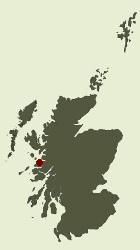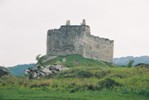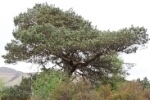 Tioram Castle
Tioram Castle
Tioram Castle (pronounced as "chee-rum") is situated on a small tidal island (Eilean Tioram, meaning "the dry island") in the west of Scotland. The island is completely cut off at high tide. The island is mentioned in charters, so given its size, it must have played a significant role. Open sea, lochs and rivers used to be Scotland's main roads and various archaeological finds confirm that Eilean Tioram was strategically important.
The entire west coast, including the isles, was a MacDonald bastion. The progenitor of the various MacDonald clans is called Somerled, a twelfth-century leader of mixed Scots and Norse origin. On his death his lands were divided between his sons. Moidart, which included Eilean Tioram, became part of the Garmoran lands. Christina MacRuari inherited these lands in the fourteenth century, then it went to her half-brother Ruari, and eventually to Christina's niece, Amy MacRuari. It was Amy, who improved the already existing building on Eilean Tioram. 
Amy was the first
wife of John of Isla, first Lord of the Isles (he later switched her for a more advantageously interesting wife). Their son Ranald was granted several lands, including the land and castle of "Elantyrim". King Robert II confirmed him in these possessions. Ranald became the first chief of the MacDonalds of Clanranald. He died in Tioram Castle in 1386.
The castle has as turbulent a history as its owners were colourful. Let me give you a brief history.
Alan, second chief, fought at the bloody Battle of Harlaw in 1411, when he sided with the Lord of the Isles against the Crown.
(You'll see, there's a pattern in this: MacDonald versus the Crown. The Stuart dynasty really wasn't too fond of the MacDonald power in the west.)
The fourth chief, also called Allan, was executed by James V after participating in a raid on Atholl.
His son was also hanged by the Crown.
The sixth chief, Dugald, was murdered by his own clansmen and replaced by his uncle.
The eighth chief, Iain Moidarth, was kidnapped by the
Crown and held in Edinburgh Castle. He escaped and recovered his lands after Tioram Castle had been seized by one of his kin on his mother's side (Frasers). The Clanranalds and Frasers fought a bloody battle at Loch Lochy, where Iain triumphed. The earls of Argyll and Atholl then attacked the castle, but could not conquer it. Iain had a troublesome relationship with the Crown for the rest of his life, but he still lived a long life and died in his castle.
 Donald, eleventh chief, was imprisoned by the government and only released when he agreed to obey the king and his laws.
Donald, eleventh chief, was imprisoned by the government and only released when he agreed to obey the king and his laws.
John, twelfth chief,
is reputed to have engaged in piracy.
Donald, thirteenth chief, was notorious for his cruelty. (Weren't they a lovable bunch?)
Allan, fourteenth chief, unfortunately heralded the end of Tioram Castle as a family residence. He was raised elsewhere and moved the clan seat in 1685. During the 1715 Rising (when the ousted Stuart dynasty suddenly needed the MacDonalds to regain their throne) Allan ordered the castle to be burnt, so the Government could not use it. He died of mortal injuries sustained at the Battle of Sheriffmuir.
The building fell into further disrepair, but when a millionaire businessman bought the property in 1997, there was great hope that the castle would receive some urgent TLC. One of the walls was then about to collapse. The owner wanted to spend some £4.5 million to renovate the building. He intended to turn the castle into a domestic home with private apartments, a clan museum... and limited public access. Historic Scotland turned it down. They wanted to have the castle conserved and not restored. During the bickering, a major structural collapse occurred at one of the walls. Visitors are no longer allowed inside the castle. Still nothing has happened since. The stalemate is utterly devastating for what's left of such a historic building.
 You can view the castle and walk to it at low tide. As said, you are no longer allowed inside because of the danger of falling masonry.
You can view the castle and walk to it at low tide. As said, you are no longer allowed inside because of the danger of falling masonry.
It is a wonderful place and very inspiring. It was this building I had in mind when I was writing Sgeulachd Castle.
 Home
Home
